Musings
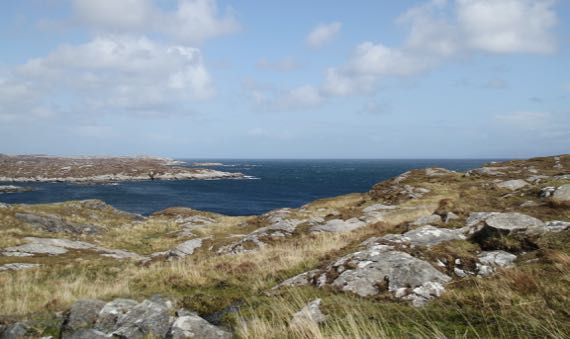
Rainy morning kept us close to the coffee pot, then we mobilized for a “Sunday drive.”
We drove into sunshine and sea-views.
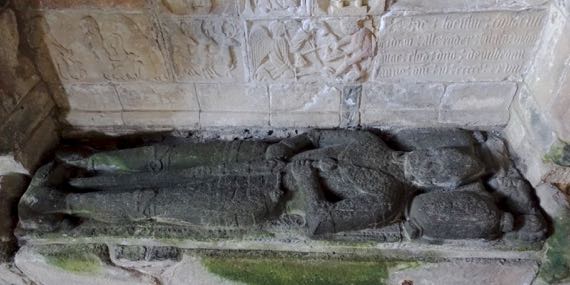
Our route took us to a ca. 1500s church (or it dated to then “originally”), no longer hosting sermons and serious talk. However, several important Jacobite and post-Jacobite MacLeods had themselves planted here…. The black stone of the knight-of-death is from their other home-island, Skye (as I understand it).
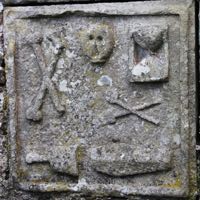
Several grave-markers in this church and church-yard used these symbols. I found it most difficult to get past the crossed long-bones (like femurs). Why did they bother me more than the skull-representations? No answer.
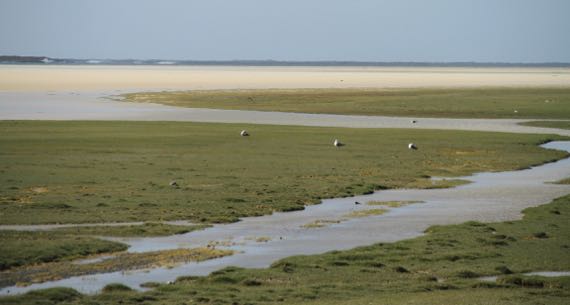
We moved beyond into the land of MaNature, and these tidal flat areas (if that is what they were), along with the shallows tinted by waterborn golden sands, captured my eye.
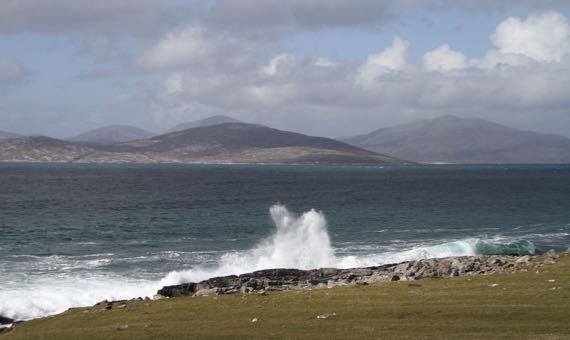
Another bay or so up the road, we found crashing surf and glorious blue waters near-shore….
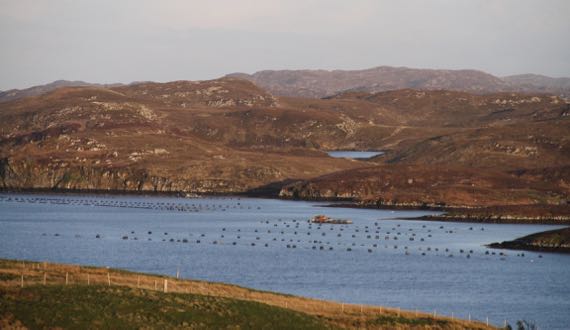
Later, back at our ranchito-of-the-moment, we watched the light change over the mussel-ranchito-of-the-loch…and the moon rise above (not shown).
Lovely day!
Posted at 6:46 PM |
Comments Off on We moved on from the morning’s rain
We moved through the landscape like we were nudge-budging time.
We began with an unexpected tire event…on the OTHER rental car…. Some confusion on my part, as we both, that is each couple, arrived here in a white rental car…. After several attempts, I finally got straightened out…and permission was given for tire replacement/fixing to happen, using a nonspecified contractor…. Then we discovered that the tyre business we could find (TY, G__gle!) in these parts is closed Sat and Sun, so the next phase of the tire fixing event will happen Monday…. The “boys” installed the “real” spare, and the car is back safely in the driveway, awaiting the weekday opening….
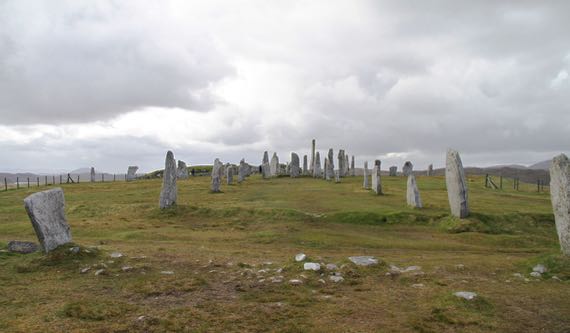
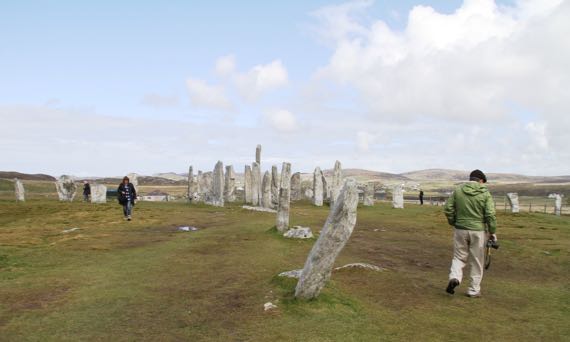
Our first (scheduled) stop was this fantastic four-pointed array of standing stones with a circle of stones and even a burial cairn in the center. What we see today is the result of several hundred years of additions and modifications…. Plus agricultural use as late as fifty (I think) years ago, when this was a potato field (if I have it right).
For me, the space and place was magical in that this hilltop and the laboriously erected stones seemed like a place where peace reigned. My projection? Probably.
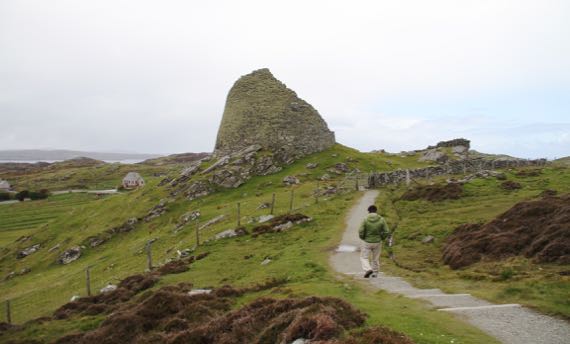
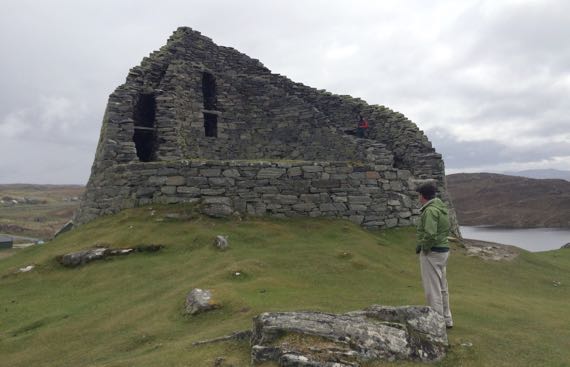
This magnificent circular structure dates perhaps a millennia closer to our own times, but still in the distant past. We read that no one knew the purpose of these huge circular buildings, and we also read about how it contained multiple levels of living spaces, likely used by several…families…. This broch (Friendly Autocorrect: plz don’t change it to broth again!) is huge and within the two-walled enclosure were steps and passages that permitted movement up and down, from level to level.
Very moving. Very different from the standing stones/stone circle….
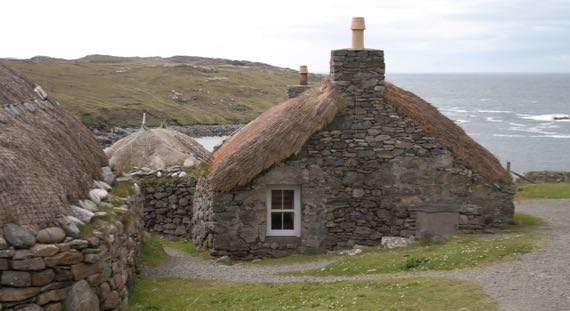
We also visited a blackhouse village (that’s blackhouse not blockhouse, Friendly Autocorrect). The last residents moved out maybe in the 1950s(?), and about 15 yrs ago preservationists began to reconstruct and preserve this cluster of blackhouses. We found displays and people here extremely informative…but I neglected to discover the reason behind the naming…. I heard that previously there were white-houses, hence the name as the structures contrasted in some way. I also heard that the peat fires inside blackened the interiors. Mostly, I just absorbed what it might have been like to live in spaces with your sheep/cattle, to have a dirt floor in your house, and to nearly always have your nostrils filled with the scent of burning peat. My imagination may not match reality.
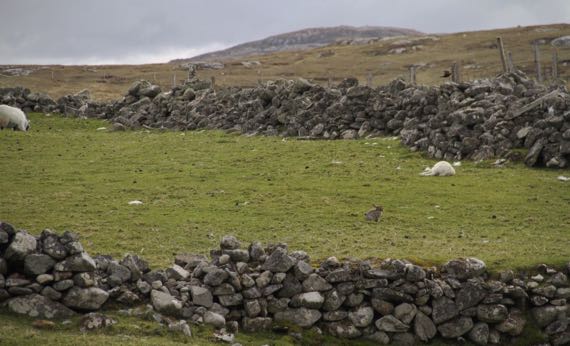
Adjacent to the blackhouse village was a rabbit village. [Rabbit is more central and in the fore-ground than sleeping lamb. Rabbit’s friends and relatives didn’t make this crop….]
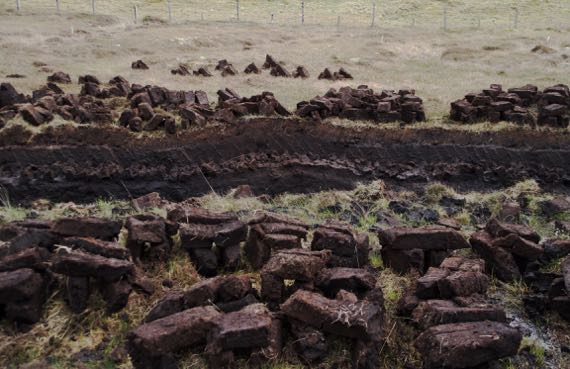
Still trying to figure out the complexities of peat cutting and drying. From my limited understanding, this bunch of peats is in the first stage of the drying process, which may take at least six weeks and can be longer if it’s repeatedly rainy.
Very exciting day all around. Plus, we watched the moon above, and we have seen the loch in front of our rented cottage in the hinterlands become still-surfaced. Given the constancy of the wind, I was very surprised by this…nature-mirror…moment.
Posted at 5:50 PM |
Comments Off on Time changes (noun verb)
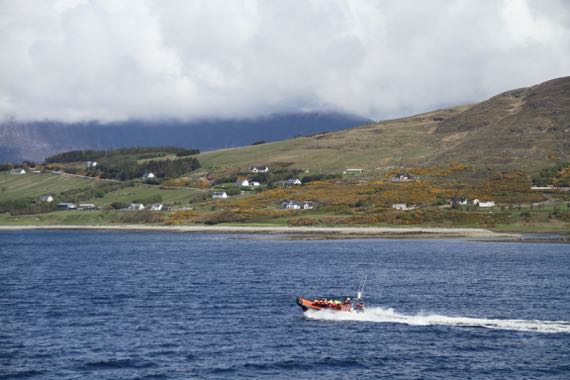
Another day, another ferry ride to an island. NOT yawn! Spotted a much smaller craft sharing our waters….

Found a colorful lighthouse…at the end of the road in one direction.

And a sandy beach in a cove at the end of the road in another direction.
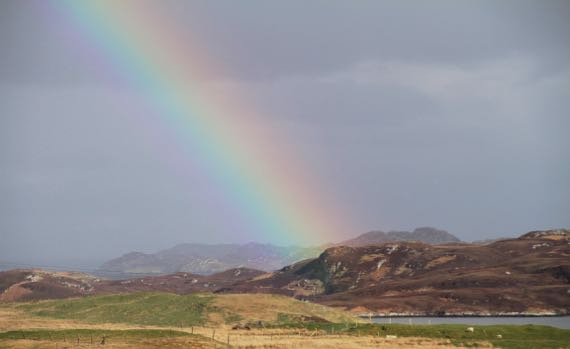
What better welcome to our new housing than this colorful presentation from the sky-deities!
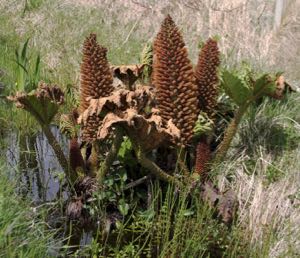
This plant is foreign to me. Found in a marshy ditch, maybe a half-dozen others within several hundred meters. Haven’t spotted it elsewhere. Distinctive. Several of the leaves are damaged, perhaps by frost? The brown pineapple-y features are from this year, not carry-overs from last year’s flowering/fruiting….
Posted at 10:22 PM |
1 Comment »
If you lived here, you’d be home now.
Needs work.
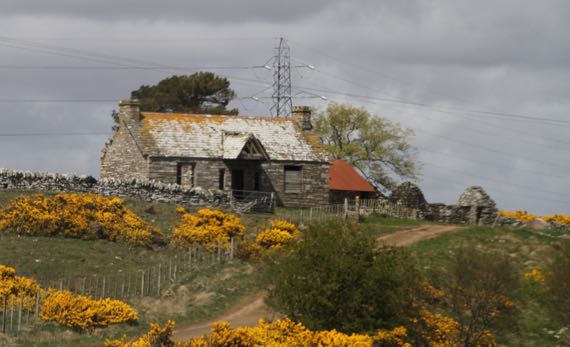
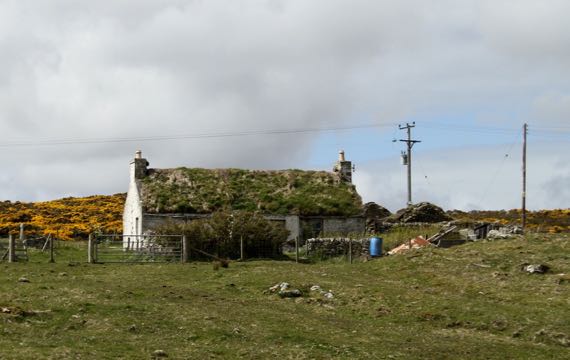
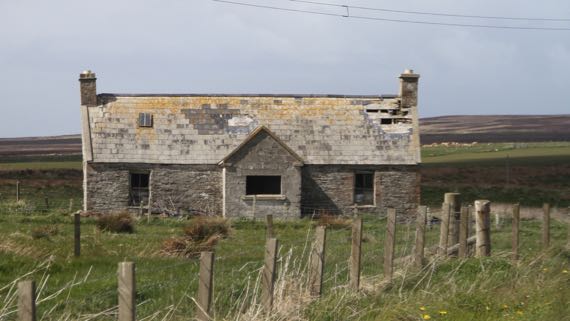
Ready to occupy.
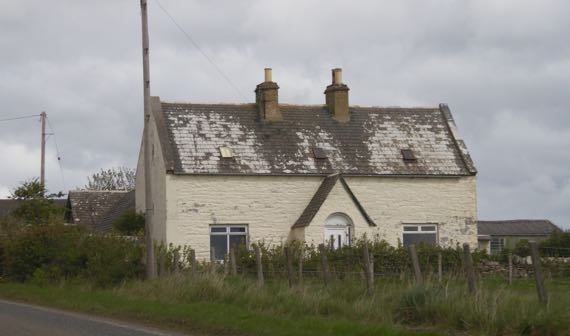
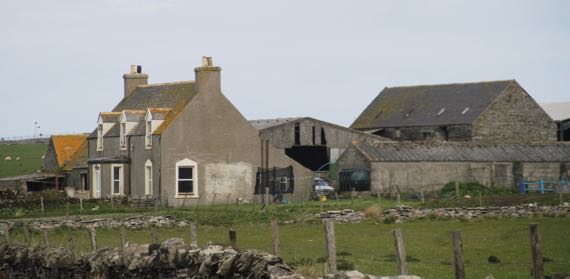
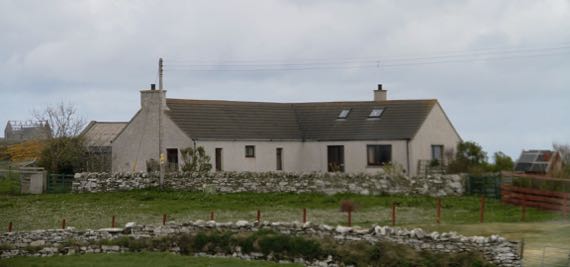
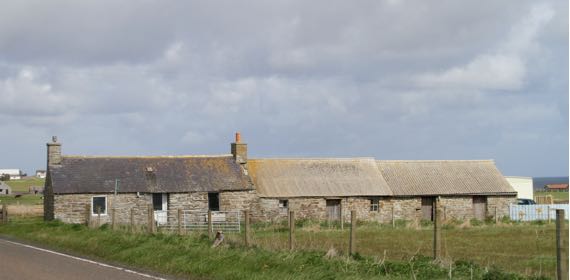
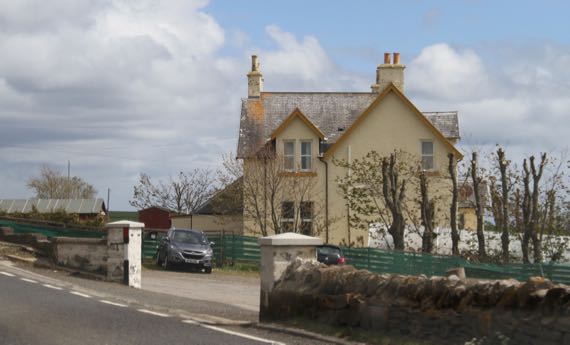
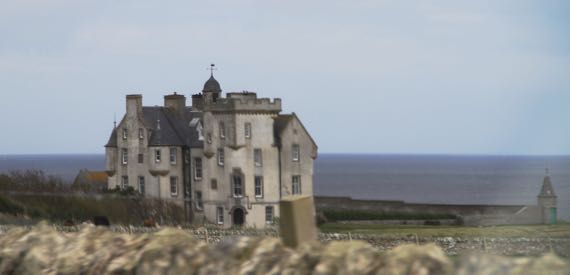
We also took a ferry. Not too much open water….
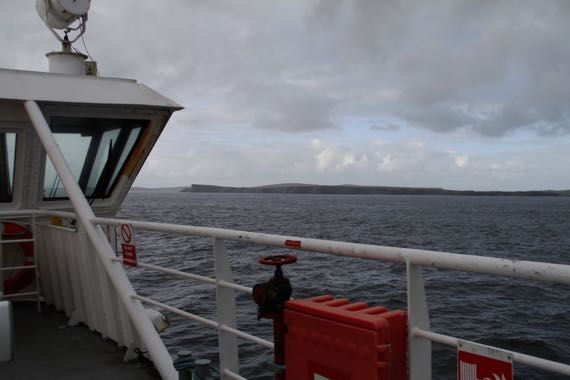
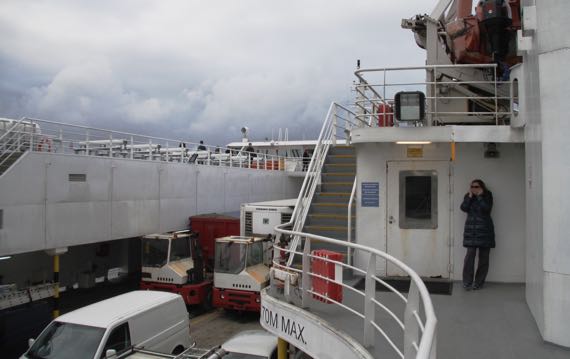
I was expecting the horn to blow at any moment. I’m in the corner because it was rather cool and windy.
The crew loaded those large trucks first. They had to back on, and did it like they’d done it dozens of times before. The crew cinched the trucks down with big chains. No chance they’d shift during passage! For most of the trip, we were serenaded by several car-alarm horns; clearly they had not been calibrated for sea-worthiness….
Posted at 10:22 PM |
Comments Off on IYLHYBHN (aka land…and sea)
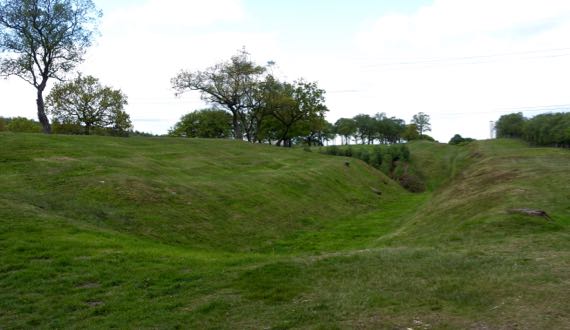
This may be the last about Roman occupation on this trip. This is a turf fort on the Antonine Wall, called Rough Castle. The Romans took twelve years to build this wall, and after eight more years they abandoned it (the forces of political economy…). To the right is the land of the barbarians, with a ditch and rampart in the mid-ground, facing the threats…to the far left is the fort, and I am standing on a gate (I assume; one sign on the whole fort…). This is the second-smallest fort along this wall, and the best preserved. It’s rough, humpy ground surrounded by a ditch, and would be a royal pain to sketch-map with a compass by pacing.
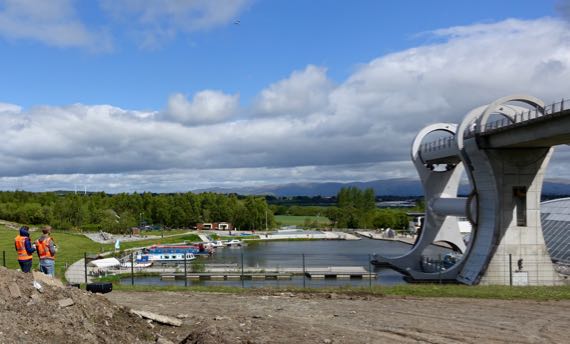
By the time we got to the other side of the hill (roughly speaking), the sun was out, and we found two guys and a drone watching the Falkirk Wheel. This is some major industrial engineering to bring boats up/down between two canals at very different heights. The drone is left of center near the top and the boat is at the bottom ready to enter the lower basin. The arm takes the boat and water on side, with a counterbalance on the other. This lift replaces eleven (I think) locks that used to be used to span the 79–foot elevation change.
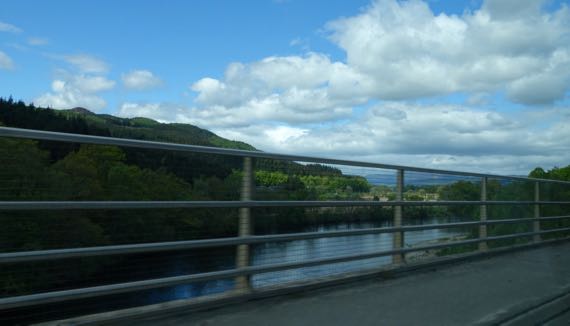
As we climbed, we saw many plantations, including bits of Tay Forest. Some of Tay Forest is old(er) growth…. And rivers, some with rocky beds and rushing water. Elevation….
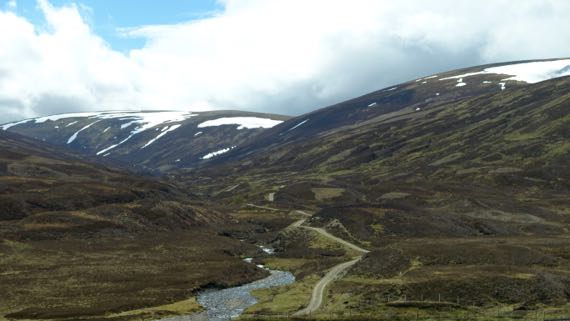
As we climbed higher, we got above the treeline (or at least where trees have not returned since the last glaciation), into glacier-rounded peaks and valleys, with some snowpack remaining. The dark brown landcover is heather. The lambs up here are much younger than at lower/warmer elevations, and most were hunkered down napping, not gamboling about, as we have seen everywhere else.
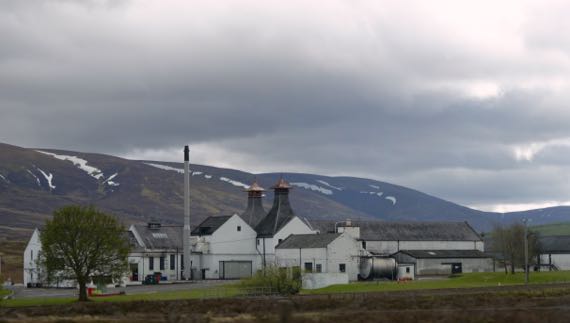
We have driven past several whisky distilleries, but have yet to stop. Crazy, eh?
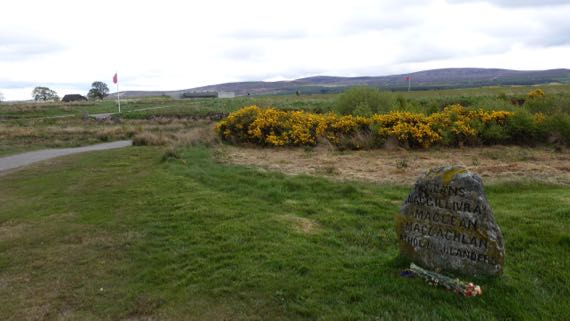
Many men died on this relatively flat moor, properly called Drumossie Muir/Moor, including Scotsmen fighting on both sides. This is where the Blàr Chùil Lodair, or Battle of Culloden, happened beginning about one in the afternoon of 16 April 1746. The Jacobites, who sought to restore their beloved Stewarts to the throne, opened with cannon fire, and English forces answered with their own cannon. As the National Trust for Scotland puts it:
Bombarded by cannon shot and mortar bombs, the Jacobite clans held back, waiting for the order to attack. At last they moved forwards, through hail, smoke, murderous gunfire and grapeshot. Around eighty paces from their enemy they started to fire their muskets and charged. Some fought ferociously. Others never reached their goal. The government troops had finally worked out bayonet tactics to challenge the dreaded Highland charge and broadsword. The Jacobites lost momentum, wavered, then fled.
Hardly an hour had passed between the first shots and the final flight of the Prince’s army. Although a short battle by European standards, it was an exceptionally bloody one.
Culloden was the last pitched battle on the British mainland, and the ramifications for the Scottish people have been immense. The English subsequently sought to suppress ethnic Scottish behaviors, including kilt-wearing, the Scottish Gaelic language, and the clan social structure. The effect of these changes was a depopulation of hinterlands, and disruption of pretty much everything Highland.
This and other rough stone markers were installed in the 19th-C. Archaeologists have used non-destructive, remote sensing techniques to define the areas where bodies were buried in mass graves.
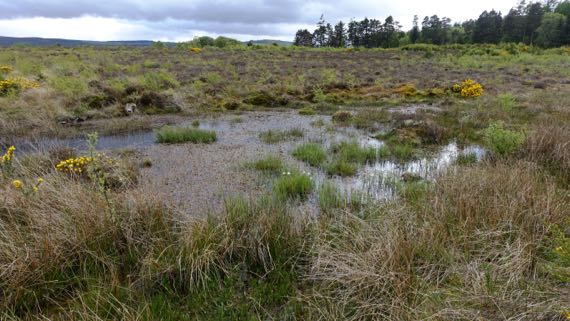
Another problem for the Jacobite troops was that the part of the battlefield they sought to cross was even wetter than today, slowing the advance of a major portion of the line. Indeed, this was a little marsh we found that would have been difficult to slog through.
Managers of the battlefield are encouraging the plant species that were here on the day of the battle, and the moor is turning from pasture into…gorse and grasses, along with wildflowers and other woody plants. One type of feature that was here in 1746, but is mostly gone now, are stone field enclosures…. The powers-that-be are also trying to convince landowners in the preservation area to refrain from tree plantations.
Such are the cycles of land management.
Posted at 4:22 PM |
Comments Off on From violence-bracing to violence
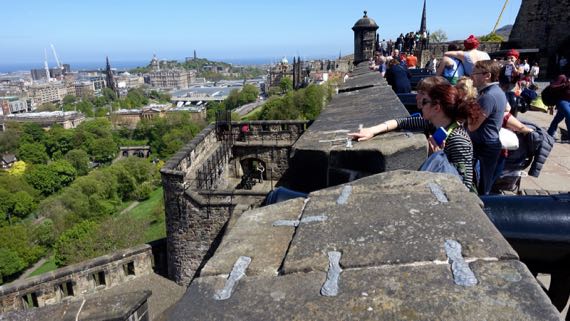
The preferred castle location: defensible, lofty, fortress position. From this massive castle hill, Edinburgh is laid out below, with occupation stretching to the Firth of Forth, where the River Forth melds with an arm of the North Sea. I loved this parapet, and the views.
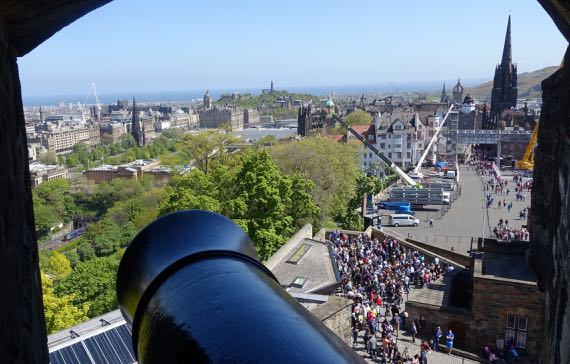
Of course, the cannons also have a great view. BTW, that mass of people to the right of the barrel and far below, sweating in the sun…that’s the line to buy tickets. It’s a holiday weekend…plus for a while, three of the six windows were closed. Sheeesh.
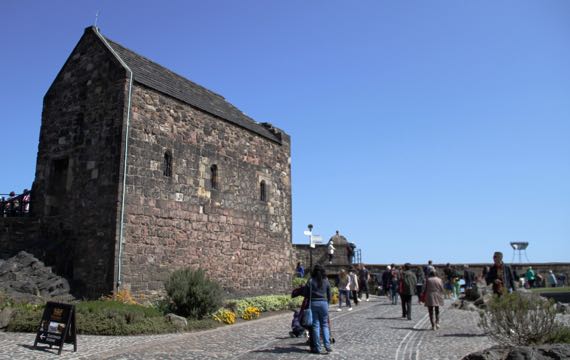
You can see a bit of the volcanic whatever that makes this feature extend far above the surrounding landscape. All the cannonballs and castle-terraforming have not eradicated or covered it. This building is the oldest one standing up here, a chapel dedicated to St. Margaret of Scotland (~1045–1093). It was built by her son, David I, previously mentioned in this space…. One of the fine things Margaret did was establish a ferry across the Firth of Forth. [Now there’s both a railroad and a road bridge.]
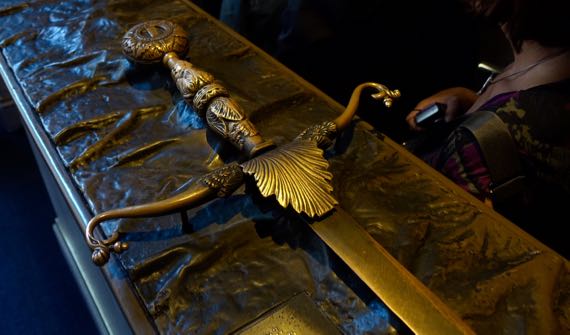
The most moving exhibit for me was our visit to the stronghold within the castle, where the Honours of Scotland are kept. These are the most symbolic objects in the nation. No photos/film allowed, so outside are bronze…not-quite-replicas. This is the claymore/sword (replica), which has a 4.5 foot blade. The real one is a bit more battered, and a bit sharper. Also in the room with the Honours is the Stone of Scone (I’ve seen pronunciation suggestions both as “soon” and to rhyme with done; haven’t heard anyone say it). I wanted to be more excited about this stone, for its history, but I couldn’t get there. The Stone has been used in coronations for something like eight centuries, customarily stored in the chair in which the sovereign sits when the coronation happens. It has a checkered history, and many doubt that this is the original. No matter; it remains very meaningful today. It was in England for recent centuries, and used in coronations there, and finally returned to Scotland in 1996. It’s not pretty, just rough, pitted sandstone, and suffers in comparison to the shiny and glittering sword, scepter, and crown in the same display.
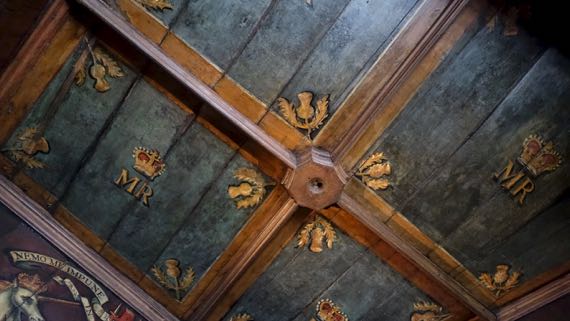
This is the ceiling of the bedchamber of Mary, Queen of Scots. It’s a small room, with nice wood paneling. And a window. And paintings on the walls just below the ceiling. I have no idea what furniture was in this room; there’s just a chair now.
I kept trying to visualize the pre-Scottish fort that was here, and the earlier castle-layout(s). This castle is still in active use, for official activities, for rental, and of course for tourism. Outside the gate, they’re installing a huge seating gallery, using giant cranes to lift large steel I-beams into position. I didn’t catch what it’s for….
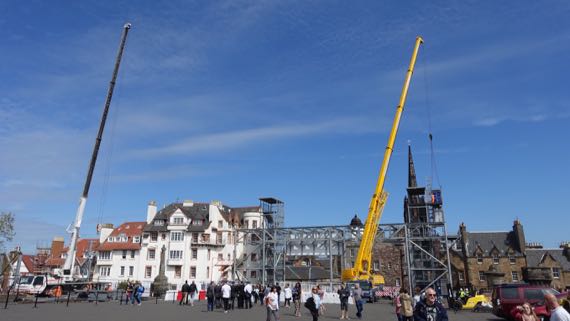
Posted at 6:36 PM |
Comments Off on Super-castle!
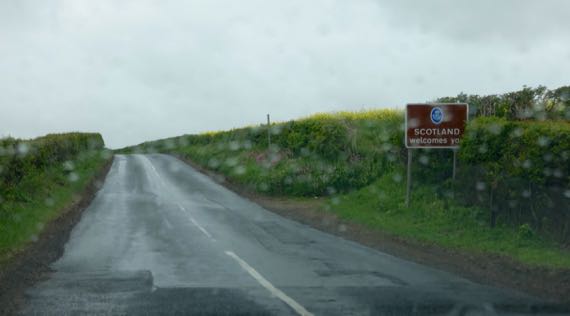
Today was designated Abbey Day in our itinerary. It was not wrong. What we really did that was most important was get to…Scotland! (And, yes, mostly we had a rainy day.)
Historically, as today, there’s a sociopolitical core to the north and south on this great island, and somewhere on the lands between has been a border zone. Today, the border’s an agreed-upon line across the landscape. For generations, it was a wide swath of contention. The border was generally porous, often dangerous, and yet had economic potential in an agrarian economy. And, land, after all, is land, and land is territory.
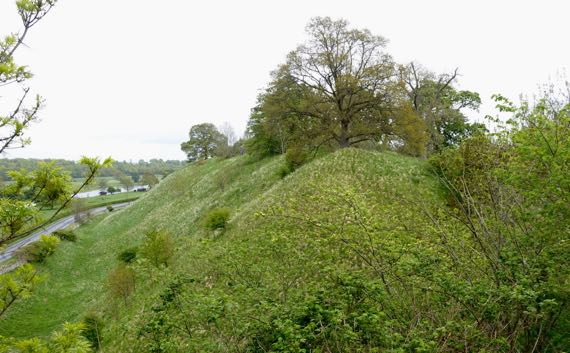
From the 1100s–1400s, a castle on this hill, between two rivers, was a political and economic center. Kings lived here, and both the northern and southern sides held it in repeated succession cycles. This was Roxburgh Castle, founded in the mid-1100s by David I, King of the Scots from 1124 until his death in 1153. Now, at the foot of this rough double-hill, there’s a small layby with room for maybe four vehicles, and no signage.
King Henry I (coronated 1100, died 1135; fourth son of William the Conqueror, King of Normandy) held sway in England, but suffered from pressures brought by rulers on the continent, in Normandy and elsewhere on the northern rim.
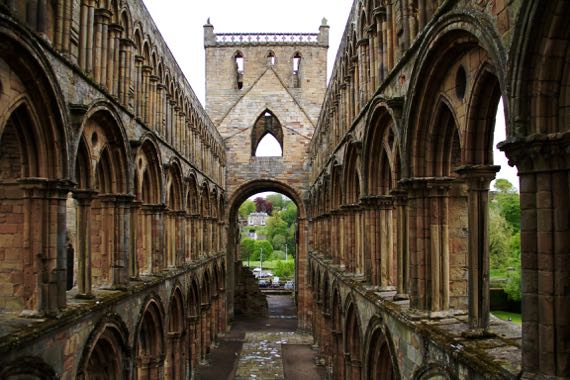
The economic and political elite of the time included both nobility and the guys who controlled large abbeys-and-churches. They were two sides of the leadership coin. Yet, the petty kingdoms of the time rarely could dominate the peripheries for long. Accordingly, cagey religious leaders were happy to build and run Jedburgh (above) and several other abbeys not far from the Roxburgh core that for centuries held sway in the borderlands—and to feed off and accept the wealth of the nobility as donations to fund repeated monk-prayers (see how well it worked, the buildings of…almost…all are now in ruins). The leadership of some of these abbeys came from afar, others from Lindisfarne….
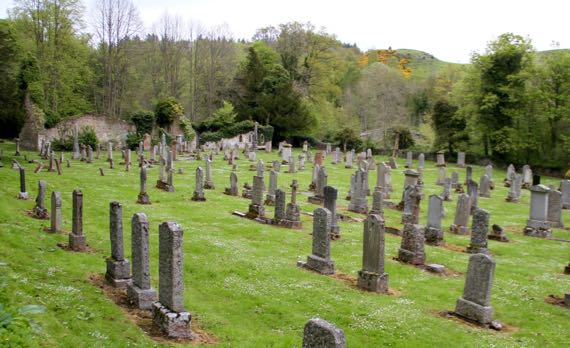
Into this general pattern of upheaval over the centuries, the place I found most interesting that we visited relates to my family history…. Traced through my mother’s father’s mother’s ancestors, we get back, after something like a dozen generations, to the Livingstons of Ancrum, post-Reformation (them, post-Dissolution) men of god here. The original Christian outpost here was established by David I, and it became a parish church after the Reformation in 1560. John Livingston became the minister here in 1648. Some of his relations migrated to the New World in the later 1600s, including signer of the Declaration of Independence for New York Philip Livingston (1716–1778). Anyway, (somewhat tenuous) family ties to the village of Ancrum (pop. ~300). In older times, the town center was west of the modern town center, near the ruined church, now surrounded by (mostly) 19th- and 20th-C headstones, and across the river from the ruins of a flax mill….
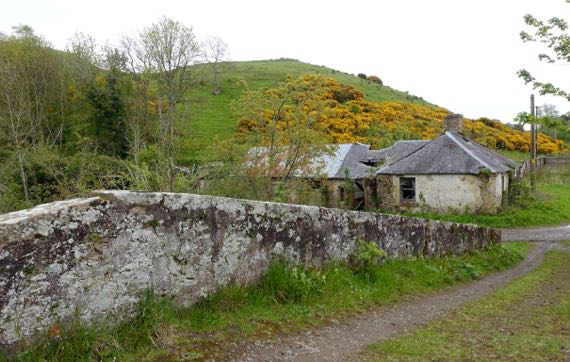
The icing on the cake…across that bridge by the church-cemetery, and up on the hill that has yellow blooms on the woody shrubs, are the remains of an Iron Age ring fort!
Posted at 10:22 PM |
Comments Off on From kings to peasants, via local leaders
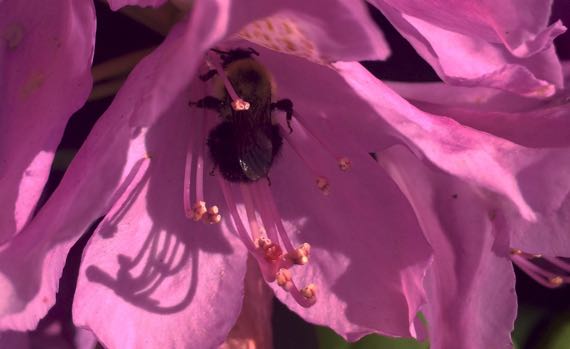
This is a rhododendron, although the individual blooms in the clusters look a lot like azalea blooms. Apparently, the anther count varies.
Posted at 9:50 PM |
Comments Off on Bumble rumble
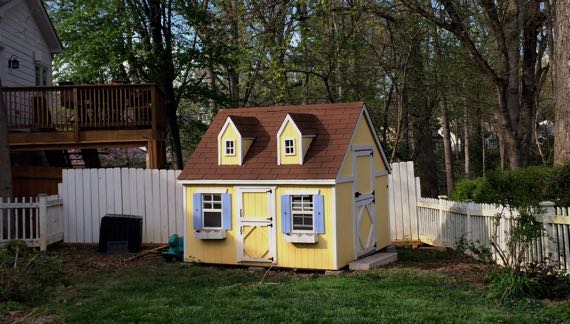
I walked past the neighbors’ house, and it was a pile of rubble. I think it was felled this morning. I knew this was coming….
Instead of giving you a photo of the slightly depressing hill of random building material, I present this sweet little pastel playhouse.
Posted at 8:52 PM |
Comments Off on Architectural transitions
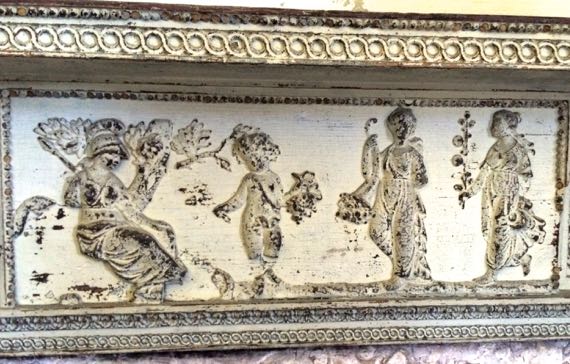
Drayton Hall, c. 1750 (but for over a century believed to date a decade earlier), mantel detail.
We visited the American version of the English version of Classical Greek/Roman decorative arts. Not sure what mythical moment this is honoring, maybe…let’s look at flowers because it’s really cold out…thankfully sunny, but still cold.
A little chemistry and political economy…. In the depression that followed the Civil…umhem, War between the States, an economic downturn that lasted for about six decades in the Charleston (SC) area, savvy landholders benefitted from mining calcium phosphate along the Ashley River and nearby (upstream of Charleston). The calcium phosphate was processed to make particularly rich agricultural fertilizer. By the 1880s, the phosphate from this field dominated world production. But it didn’t last long…new fields discovered in Florida were easier to mine, and there were other market shifts.
Enough of this…sleep tight.
Posted at 9:32 PM |
1 Comment »

















































